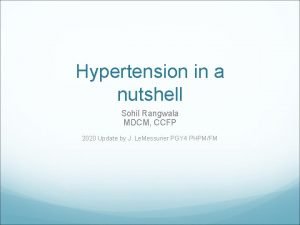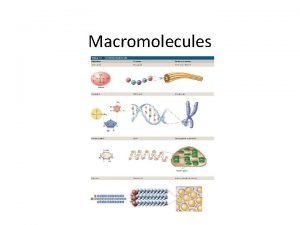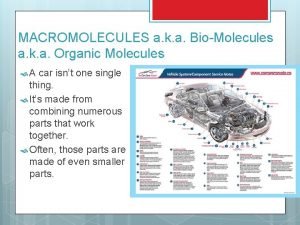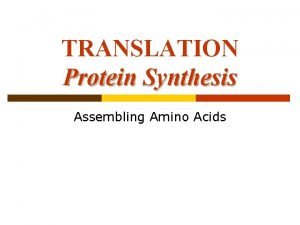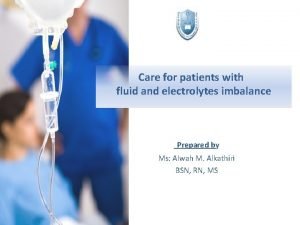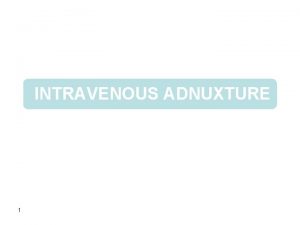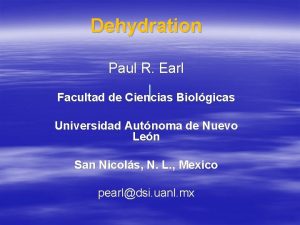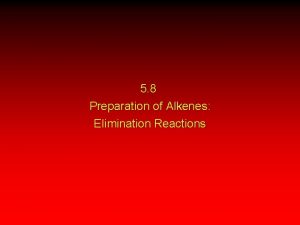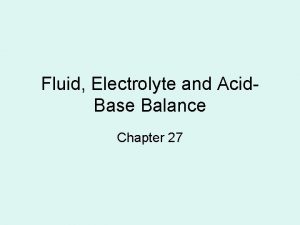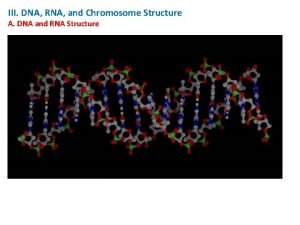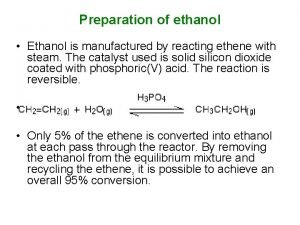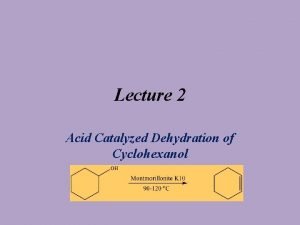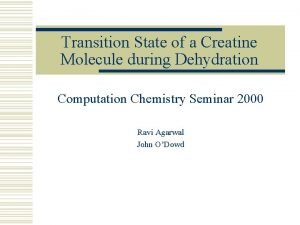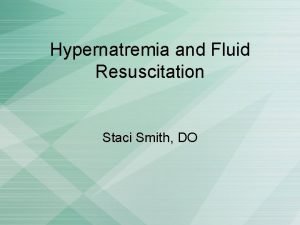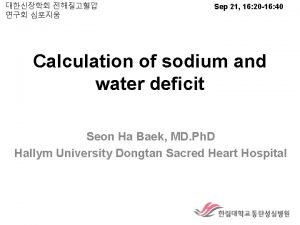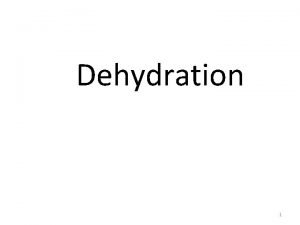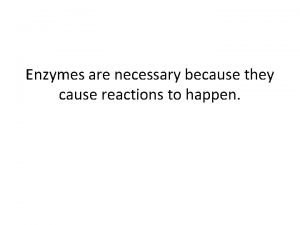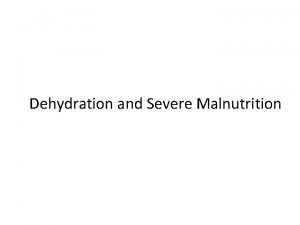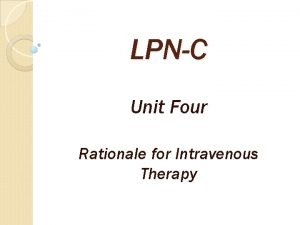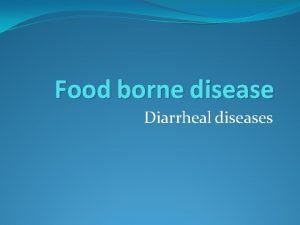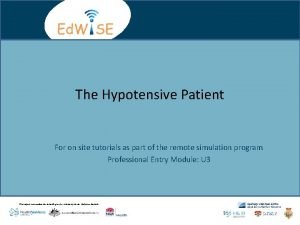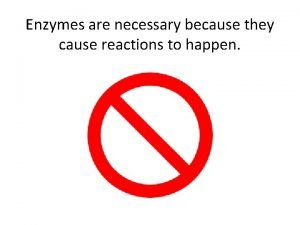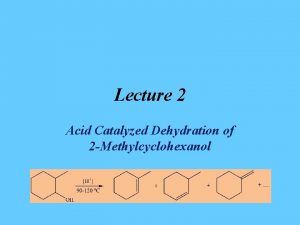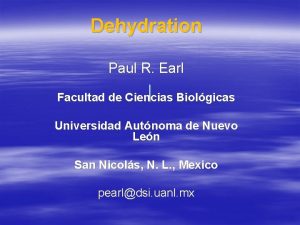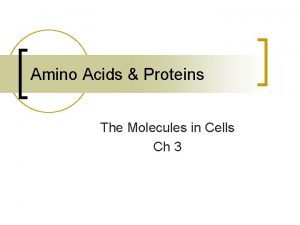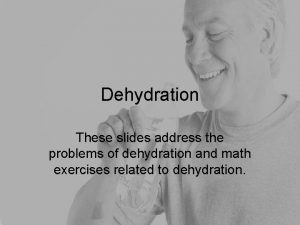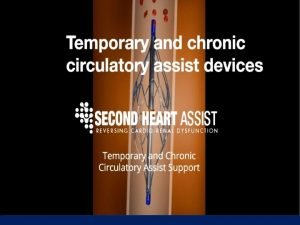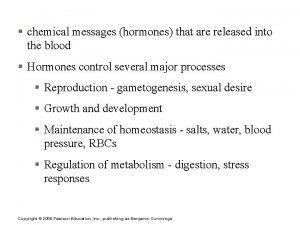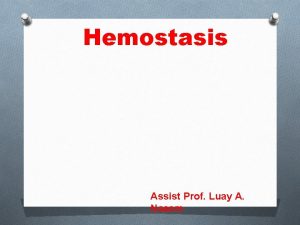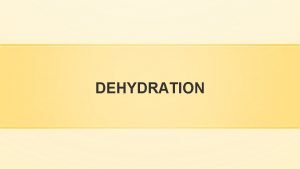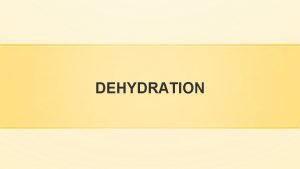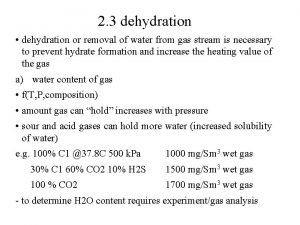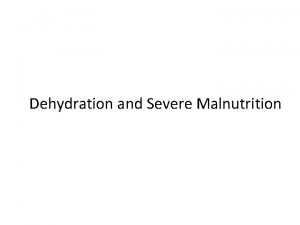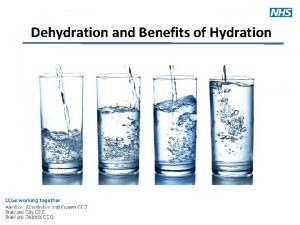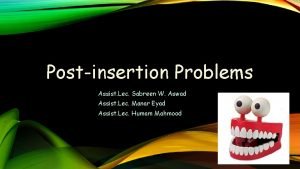Diagnosing Dehydration Assist Prof Luay A Naeem Diagnosing














































- Slides: 46

Diagnosing Dehydration Assist Prof. Luay A. Naeem

Diagnosing Dehydration Physical exam Weight loss PCV (HCT) o INCREASED Albumin or total protein o INCREASED Creatinine o INCREASED =“Prerenal azotemia”

Skin Tint Elasticity of the skin will vary depending on the amount of fat in the subcutaneous tissues Old animals or thin animals may have reduced skin elasticity Fat animals may have a normal skin tint even when dehydrated


What are the principles and protocols for fluid management? Prescribing 1. 2. 3. 4. 5. IV fluids: Routine maintenance. Resuscitation. Replacement. Redistribution. Reassessment. Remember 5 Rs

Fluids: How Much to Give? Correct dehydration Weight in kg times percent dehydration equals the amount in liters that the animal is dehydrated Example: 10 kg animal who is 8% dehydrated 10 kg X 0. 08 = 0. 8 liters Patient is lacking 0. 8 liters, or 800 ml fluids

How Much to Give? o Correct dehydration Maintenance fluids

Maintenance Fluids 30 ml/pound/day 10 pound animal needs: 10 X 30 ml/lb =300 ml/day

How Much to Give? o Correct dehydration o Maintenance fluids On-going losses

On-going Losses Sensible losses o GI disease • Vomiting/diarrhea o Renal disease • Low specific gravity o Diabetes mellitus Insensible losses (evaporation/diffusio n) o Weigh to determine

Fluid Needs Correct dehydration Maintenance needs On-going losses

Principles of Rehydration 1. Correct dehydration, electrolyte, and acid-base abnormalities prior to surgery

Principles of Rehydration 2. Do not attempt to replace chronic fluid losses all at once o Severe dilution of plasma proteins, blood cells and electrolytes may result Aim for 80% rehydration within 24 hours Monitor pulmonary, renal and cardiac function closely

Types of Fluids Crystalloids o 0. 9% Na. Cl o Lactated Ringers Solution o 5% Dextrose in water o Plasmalyte, Normosol, etc

Crystalloid Fluids Isotonic o Mimic plasma electrolyte concentrations Hypertonic o Follow with isotonic

Lactated Ringer’s Solution • Contains physiological concentrations of: sodium, chloride, potassium, and calcium Also contains lactate, which is metabolized by the liver alkaline-forming Because small animals that are sick or under anesthesia tend towards acidosis

Ringer’s Solution Same as LRS except no lactate added Commonly used in Large animals Why? o Large animals who are sick tend towards alkalosis instead of acidosis

Saline 0. 9% Sodium chloride = ISOTONIC Lacking in K+, Ca 2+ Used for hyperkalemia, hypercalcemia Used as a carrier for some drugs Used if don’t want lactate

Dextrose Solutions 5% dextrose is isotonic 50% dextrose commonly found Used for hypoglycemia, neonates, hyperkalemia, as part of Total Parenteral Nutrition


What criteria should be considered before prescribing IV fluid therapy for a post op patient? Age Sex Body weight. Pre op hydration status of the person. Associated co morbidities. Type of surgery. Duration of surgery. Blood loss.

Additives for Crystalloid Solutions Potassium o available as potassium chloride (KCl) o available as potassium phosphate (K 3 PO 4) Very common additive o 20 meq in 10 ml bottle

Potassium DANGER: Rates higher than 0. 5 meq/kg/hr will stop the heart Added to fluids at 10 -80 meq/L o Amount depends on how low K is o Obtain WRITTEN approval from vet IF ADDING >40 meq to L (2 btls) o DOUBLE CHECK with Veterinarian

Calculating Safe Rates for Infusions Containing KCl (Weight) (Dosage) Concentration Body weight in kg X 0. 5 meq/kg/hr = maximum amount of potassium allowable Figure out the concentration of the fluids being administered in terms of meq/ml Divide weight times dosage by the concentration of potassium in the fluids Answer is the fastest allowable rate per hour o Set rate less than this to be safe

Step 1: Maximum Dose 1. Body wt in kg X 0. 5 meq/kg/hr = maximum amount of potassium allowable 8. 8 pound cat 2. 2 = 4 kg cat X 0. 5 meq/kg/hr = 2 meq per hour allowable

Step 2: Figure Out the Concentration If fluids contain 60 meq/l then each ml contains 0. 06 meq (60 divided by 1000 ml in a liter) 60 meq 1 liter x 1 liter 1000 ml 60 meq 0. 06 meq = 1000 ml = ml

Step 3: Divide Dose by Concentration Divide dose (2 meq/hr) by concentration (0. 06 meq/ml) 2 meq/hr 0. 06 meq/ml = 33 ml/hr Maximum safe rate would be 33 ml/hr

Weight X Dosage Concentration

Sodium Bicarbonate Alkalinizing Used for severe acidosis o Antifreeze toxicity o Ketoacidosis associated with diabetes mellitus Do not add to calcium-containing fluids or calcium precipitates will occur

B Vitamins B Complex Frequent additive; water-soluble effects Turns bag yellow Protect from light 1 -2 ml/liter Appetite Stimulant, Replaces lost B vitamin

Additives Always label the fluid bag with the amount and concentration of all additives immediately! Date fluids

Daily Monitoring While on Fluids: Weigh daily patient

Daily Monitoring Auscult the lungs o Crackles o Wheezes o Nasal discharge • Serous

Daily Monitoring Urine production

Daily Monitoring Central venous pressure

Daily Fluid Monitoring Overdose: o Serous nasal discharge o Dyspnea, crackles o Restlessness o Decreased PCV, TP o Increased BP

IV Catheters Size: In GAUGES like needles o Smaller = BIGGER Types: o Cephalic • How long in? o Jugular • How long in? • Other Advantages?

Flushing Flush w/ Heparinized Saline o 1 cc (1, 000/m. L) into 1000 m. L Flush after first piece of tape o Make sure it’s in Flush before each injection Flush after each injection Flush every 4 -6 hours if not used

So How Is It Delivered? Infusion pump (easy) IV drip set: drops per ml written on package Regular Drip sets have 10, 15, or 20 drops per ml o Med – large dogs Micro ml drip sets have 60 drops per o Small dogs - cats

Intra-operative Fluids: 10 ml/kg/hr first hour, then reduce to 5 ml/kg/hr Example: 10 kg dog would get: o (10 ml/kg) (10 kg) = 100 ml in the first hour o 50 ml in the second hour

Calculate Drops Per Hour 1. 2. Calculate ml/hr (as far as you go for PRI) Calculate drops/hr by: o ml/hr X drops/ml (from the package) o Gives you drops needed in an hour Example: 100 ml X 10 gtt per ml = 1000 drops in the first hour

Calculate Drops Per Minute 3. Divide drops per hour by 60 min/hr to get drops per minute Ex: 1000 gtt/ hr divided by 60 minutes per hour = 16. 7 gtt per minute 16. 7 gtt/min divided by 60 sec per min = 0. 28 gtt/sec

So What? What if you don’t want to count drops over a whole minute? If you want to count over a 30 second period of time, then divide by two If you want to count over a 15 -second period of time, divide by four

Ex: 16. 7/min divided by 2 = about 8 drops over 30 seconds 16. 7/min divided by 4 equals about 4 drops over 15 seconds

All together… x kg x 10 m. L x 1 hr x 1 min x x gtt 1 kg/hr 60 min 60 sec m. L = wt x 10 x gtt Gives you gtt/sec 3600 sec Then make it into a usable # of gtt / so many sec

Calculating Fluid Requirements in Hospitalized Animals Maintenance fluids plus Replacement fluids (80% of deficit) plus On-going losses equals Total Fluid needs over 1 st 24 HRS
 Gtaba
Gtaba Comprehensive model for diagnosing organizational systems
Comprehensive model for diagnosing organizational systems Diagnosing error in object detectors
Diagnosing error in object detectors A defective vacuum brake booster will cause a ________.
A defective vacuum brake booster will cause a ________. Rheumatoid arthritis in hands
Rheumatoid arthritis in hands What is office blood pressure
What is office blood pressure Diagnosing your cultural intelligence
Diagnosing your cultural intelligence Hypertensive emergency
Hypertensive emergency All compounds can be classified in 2 broad categories
All compounds can be classified in 2 broad categories Fat subunits
Fat subunits Amino acid wheel chart
Amino acid wheel chart Dehydration synethesis
Dehydration synethesis Transportec
Transportec Dehydration gastritis
Dehydration gastritis Iv solution for dehydration
Iv solution for dehydration Symtons of dehydration
Symtons of dehydration Dehydration of tert butyl alcohol
Dehydration of tert butyl alcohol Mild moderate severe dehydration
Mild moderate severe dehydration Severe dehydration
Severe dehydration Rna structure
Rna structure Neopentyl alcohol dehydration
Neopentyl alcohol dehydration Acid catalyzed dehydration of cyclohexanol
Acid catalyzed dehydration of cyclohexanol Dehydration synthesis of amino acids
Dehydration synthesis of amino acids When to take creatine
When to take creatine Hypovolemia vs dehydration
Hypovolemia vs dehydration Dehydration in birds
Dehydration in birds Fluid of choice in severe dehydration
Fluid of choice in severe dehydration Types of dehydration
Types of dehydration Dehydration synthesis and hydrolysis
Dehydration synthesis and hydrolysis Resomal composition
Resomal composition Hypertonic dehydration
Hypertonic dehydration Exhibit past tense
Exhibit past tense Hydrolysis and dehydration synthesis
Hydrolysis and dehydration synthesis Crystalloid solution example
Crystalloid solution example Chapter 15 hunger games questions
Chapter 15 hunger games questions Diarrhea plan a
Diarrhea plan a Severe dehydration
Severe dehydration Dehydration in microtechnique
Dehydration in microtechnique Saytzeff rule
Saytzeff rule Dehydration vs hydrolysis
Dehydration vs hydrolysis Acid catalyzed dehydration of 2-methylcyclohexanol
Acid catalyzed dehydration of 2-methylcyclohexanol Symtons of dehydration
Symtons of dehydration Dehydration synthesis of amino acids
Dehydration synthesis of amino acids Types of dehydration
Types of dehydration Cr assist
Cr assist Leslie miller md
Leslie miller md Hormonal stimulus
Hormonal stimulus







